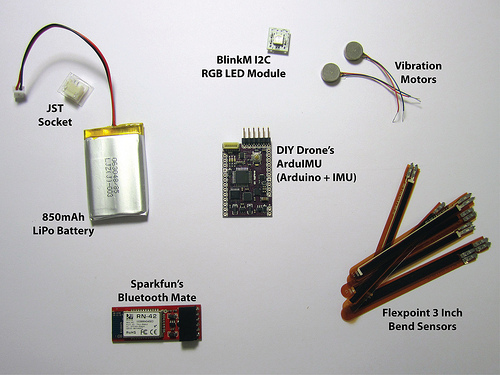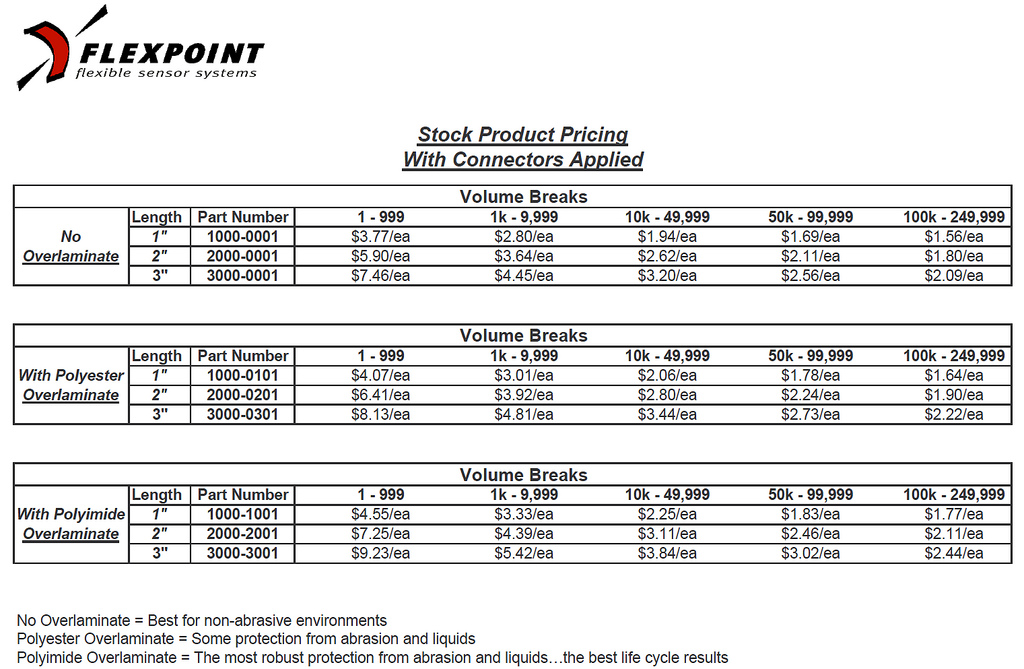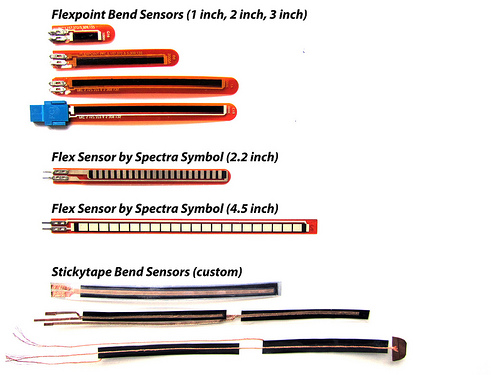Materials
An important part of starting to build The Gloves is to begin sourcing all the materials you will need to construct them from. Because The Gloves are designed to be customized you do not have to stick to the following list of materials, but rather you can improvise where you need or like to.
Since many of the electronic parts we use can be ordered from Sparkfun (USA) we have put together a wishlist on their website, but you can also source the parts from various other distributors!
Sparkfun wishlist >> https://www.sparkfun.com/wish_lists/31900
It can be some effort to pull together all the different materials and parts necessary to build a pair of gloves. Expect to spend quite some time surfing the internet for local distributors, and also check websites such as Amazon and Ebay for stuff.
Materials Summary
2 x ArduIMUs
2 x BlueTooth or FTDI cables
2 x LiPo Batteries (if wireless)
1 or 2 x LiPo Chargers (if wireless)
2 x JST sockets for battery power connection (if wireless)
10 x Bend Sensors (or more if you like)
2 x I2C RGB LED module
2 x vibration motor
1 x Sugru
20 x male and female metal snaps
1/2 meter stretch fabric
1/2 meter 2mm thick neoprene with fabric fused to either side
1 spool of thin flexible wire
20 x 20cm fusible interfacing
20 x 20cm non-stretch fabric
1 spool sewing thread


ArduIMU
So far I have only found the ArduIMU for sale in the USA from either Sparkfun or DIYDrones, though you will also have to pay shipping and customs if ordering outside USA. On Ebay I found one distributor based in UK.
DIY Drones (50USD) >> http://store.diydrones.com/ArduIMU_V3_p/kt-arduimu-30.htm
Sparkfun (70USD) >> https://www.sparkfun.com/products/11055
Ebay UK (95GBP) >> http://www.ebay.de/itm/SparkFun-DIYDrones-ArduIMU-V3-/130823640170?pt=UK_Computing_Other_Computing_Networking&hash=item1e75b2546a
Bluetooth or Wired
Bluetooth Mate Silver
Sparkfun (USA) >> https://www.sparkfun.com/products/10393?
TinkerSoup (DE) >> http://www.tinkersoup.de/product_info.php?products_id=497
Deal Extreme (China) >> http://dx.com/s/104299
FTDI Cacble (all-in-one) >> https://www.sparkfun.com/products/9718
FTDI breakout board (USB Mini cable) >> https://www.sparkfun.com/products/9716
JST Socket for Battery Power
Tinkersoup (DE) >> http://www.tinkersoup.de/product_info.php?products_id=582
Sparkfun (USA) >> https://www.sparkfun.com/products/8612
LiPo Battery
850mAH
Sparkfun >> https://www.sparkfun.com/products/341
TinkerSoup >> http://www.tinkersoup.de/product_info.php?products_id=368
LiPo Battery Charger
You only need one, but then you have to charge the two batteries (left, right) one after the other. Charging can take up to 12 hours (I think!) if they are completely empty.
LiPo charger >> https://www.sparkfun.com/products/10401
Tinkersoup (DE) >> http://www.tinkersoup.de/product_info.php?products_id=535
Bend Sensors
In the current gloves we use 3 inch bend sensors from Flexpoint and have found them to be the most robust and reliable. Have tried different versions (laminated and not laminated and so far have not noticed differences, so really it is up to you which ones to use). Here is a list to FlexPoint 2013 pricing. Place your order by calling or emailing Flexpoint, you will find their contact information on their website. They are fast to ship and you can pay with credit card. When placing your order remember to request that they do not attach the blue sockets to the sensors, otherwise you will have to remove these yourself later (see step about connecting bend sensors).
FlexPoint Bend Sensors (USA) >> http://www.flexpoint.com/companyInfo/bendSensor.htm
Flexpoint Bend Sensor pricing:

Instead of the Flexpoint bend sensors you can also use other bend/flex sensors from the following sources. The only thing is that I found some of them were badly constructed.
RS (Europe) >> http://de.rs-online.com/web/p/potenziometer/7081277/
Segor (Berlin) >> http://www.segor.de/#Q=FlexSensor%2520112mm&M=1
Tinkersoup (Germany) >> http://www.tinkersoup.de/product_info.php?products_id=111
Sparkfun (USA) >> https://www.sparkfun.com/products/8606
Sparkfun (USA) >> https://www.sparkfun.com/products/10264

Or you can also make your own bend sensors. This is something I hope to refine for future versions of The Gloves.
Stickytape bend sensors >> http://www.instructables.com/id/Stickytape-Sensors/
Heatshrink Tube and Superglue
>> http://en.wikipedia.org/wiki/Heat-shrink_tubing
Resistors
The ArduIMU has 6 analog inputs which we use for reading the values of the bend sensors. But only 4 of these analog inputs (A0, A1, A2, A3) have internal pull-up resistors (see: voltage dividers) built into the microcontroller which can be turned on in code. This means that for the remaining 2 analog inputs (A6, A7) we have to connect our own (external) pull-up resistors.
Because the range of the Flexpoint bend sensors is about 20K-300K Ohm, we use 100K Ohm resistors.
For two gloves you will want 4 x 100K Ohm resistors
Conrad (Germany) >> http://www.conrad.de/ce/de/product/405493/12-W-Kohleschicht-Widerstand-100-k-axial-bedrahtet-Bauform-0411-05-W-5-
RGB LED (I2C)
Sparkfun (i2C RGB LED module) >> https://www.sparkfun.com/products/8579
Sparkfun (RGB LED) >> https://www.sparkfun.com/products/10866
Vibration Motor
Precision Microdrives (UK) >> http://www.precisionmicrodrives.com/
Sparkfun (USA) >> https://www.sparkfun.com/products/8449
Deal Extreme (China) >> http://dx.com/p/1027-flat-vibrating-vibration-motor-silver-5-pcs-154245
Instead of the motor you could also mount a buzzer or speaker:
Segor (Berlin) >> http://www.segor.de/#Q=L-27%2520P%252F32R&M=1
Sparkfun (USA) >> https://www.sparkfun.com/products/7950
Sparkfun (USA) >> https://www.sparkfun.com/products/11089
Sugru
Sugru (UK) >> https://sugru.com/
Modulor (DE) >> http://www.modulor.de/shop/oxid.php/sid/923c4af23b123d3d920d38446e647b31/cl/details/cnid/-/anid/315180
Wire
Here is a post about thin flexible wire sources.
LIFY 0,05mm^2, 25m in 9 different colours
Conrad (DE, EU) >> http://www.conrad.at/ce/de/product/606404/LiFY-Hochflexible-Decoder-Litze-1-x-05-mm-Gelb-50-m-Conrad
Stretch Fabrics
The fabric part of the gloves is best made from a stretch material that stretches equally in all directions and keeps it’s shape well. Nylon spandex, lycra and stretch jersey have these properties, but depending on the exact fabric and quality you get, it can work well or not. If you are lucky you will find a local fabric shop that stocks stretch materials in a variety of qualities and colours for you to choose from. But otherwise you will have to resort to online shops which can be tricky when you can touch and feel the fabric in your own hands. So try emailing these shops for a selection of samples first, before placing an order.
Powermesh fabrics are robust, stretchy and transparent if you want to be able to show off the tech inside (though it does seem to wear at the seams). This is the power mesh that I ordered for a recent pair of gloves, but it looks very blue, not gray:
I’m working on sourcing an online source for the perfect glove fabrics, but have not found the perfect selection yet.
Tissu Fabrics (UK/EU) >> http://www.tissufabrics.co.uk/fabric-store/grey-power-mesh-net-4-way-stretch-fabric.html
Welt der Stoffe (Berlin) >> http://www.berlinsweltderstoffe.de
Hüco Stoffe (Berlin, Germany) >> http://www.hueco-stoffe.de/index.php?page=Main&view=oeffzeiten-anfahrt
Neoprene
HS quality, 2mm thick, polyester nylon fused to either side, colours of choice
SedoChemicals (Germany/EU) >> http://sedochemicals.de/
Foam Order (USA) >> http://www.foamorder.com/neoprene.html
Metal Snaps
7mm diameter matal snaps (you can also use different size!).
Because Velcro damages the fabrics, and also because the conductivity of metal snaps can be used to make electrical connections, we use
Plug and Wear (Italy) >> http://www.plugandwear.com/default.asp?mod=product&cat_id=95,100&product_id=166
Fusible Interfacing
You only need a small piece of this in combination with the non-stretch fabric (see bellow) to use on the back of the wrist-band circuit as strain-relief. This is something you will find at most local fabric stores. It is sold under various names such as: Interweb, Bondaweb, Fusible, Interfacing, “iron-on“, Fusible web… basically it is a double-sided fabric glue that becomes sticky when heated up with an iron. Because it is sticky on both sides it comes with a way paper on one side so that you can first fuse it to one piece of fabric, then peel off the paper backing, cut out your shape and fuse this to the other piece of fabric. In our case the fusible goes between the non-stretch fabric and the neoprene. You can also get fusible that already has a fabric adhered to one side. So long as this fabric is non-stretch and not too thick or too think, it will work fine for this purpose.
Welt der Stoffe (Berlin) >> http://www.berlinsweltderstoffe.de
Hüco Stoffe (Berlin, Germany) >> http://www.hueco-stoffe.de/index.php?page=Main&view=oeffzeiten-anfahrt
Non-Stretch Fabric
You only need a small piece of this in combination with the fusible interfacing (see previous) to use on the back of the wrist-band circuit as strain-relief. You will definitely find some sort of non-stretch fabric in a local fabric shop, or even ask a friend or use an old piece of clothing.
Thread
Thread is something you can definitely get at a local fabric store. You want thread that can run in your sewing machine. You can pick the colours to match your fabric. When sewing the wires to the neoprene you can either pick a colour that matches the wire isolation to make the stitches less apparent, or pick a colour that will make them stand out.
Thanks SO much for sharing this. Very ambitious of me to want to try, but what the heck! On the Sparkfun wish list I note you have listed x10 2 x ArduIMUs…where as elsewhere only 2? Are we looking at 10 or 2 - it makes a rather big difference budget wise
Thanks again for this awesome idea / contribution.
yes, you only need 2 ArduIMUs, one for each hand.
Thanks for asking, Karin, and thanks for the clarification Hannah! $1500 to $500 is a huge difference indeed.
Besides Sparkfun’s parts, there’s some extra ones, correct? How much do you think is the total budget for a project like this project? Just want to have an idea if it’s a lot more than $600 or so..
This is an awesome source! You guys rule
Thanks for the detail illustration of making data gloves. Survey some existing gloves, they are really pricey. We plan to build one to study on sign language
Hi,
Is there any cheaper material alternative to the neoprene that can be used instead?
Thanks!
there are cheaper versions of “fake neoprene” that are foam with fabrics fused to either side - these might work. or else leather would be a nice variation. you could also try a thick felt.
Hello Hannah,
How many metal snaps are needed?
In the list above you say 20 pairs (male female) are needed,
but in the pictures I can count only 5 pairs (2 on the wrist, and 3
at the edges of the neoprene piece - near the knuckles).
Thanks,
Moshe
P.S. You mentioned in a different comment thread that the Glover software might be available soon, is there any progress concerning the publication of the software? thanks!
i should make an illustration that marks all the snaps. but for now i hope the following information is useful.
ammounts are for one glove:
- 6 female on the cuff for fastening, but this can be reduced to 2 if you are only making it to fit one size
- 2 male snaps on cuff for fastening
- 1 female snap on glove for LED fixation
- 1 male snap on cuff for LED fixation
- 2 female snaps on cuff for electrical contacts and fixation
- 2 male snaps on vibration motor module for electrical contacts and fixation
total female: 9
total male: 5
* always a good idea to have a few extra!